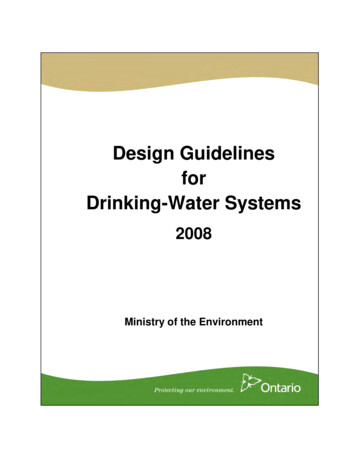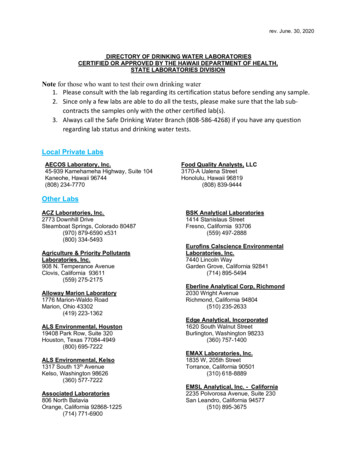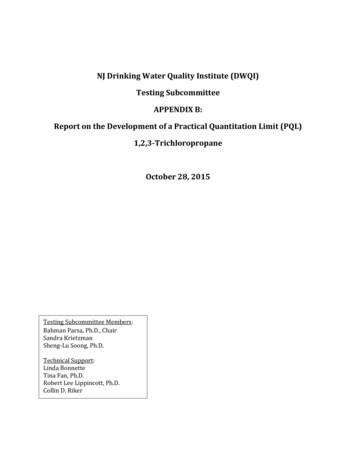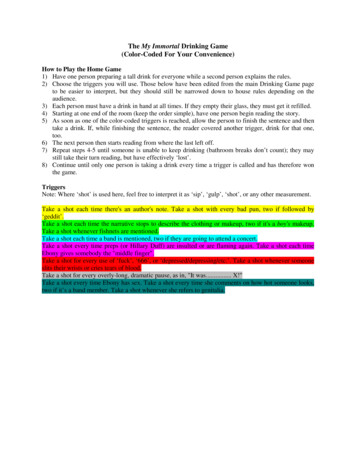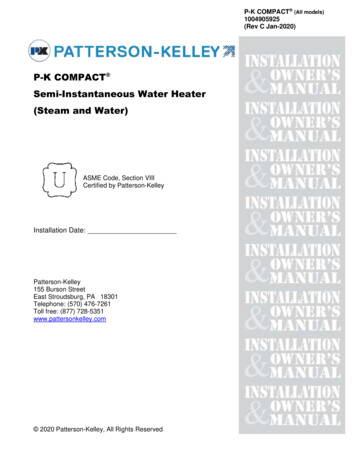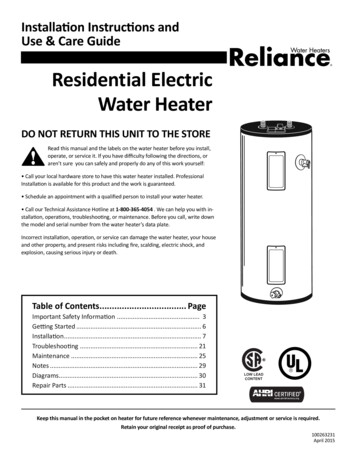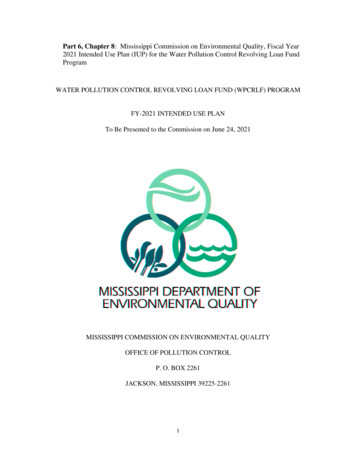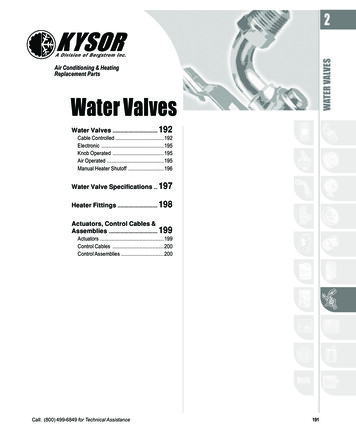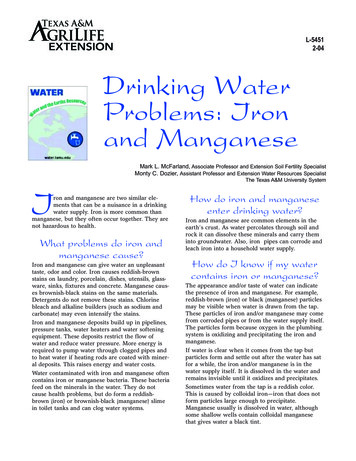
Transcription
L-54512-04Drinking WaterProblems: Ironand ManganeseMark L. McFarland, Associate Professor and Extension Soil Fertility SpecialistMonty C. Dozier, Assistant Professor and Extension Water Resources SpecialistThe Texas A&M University SystemIron and manganese are two similar elements that can be a nuisance in a drinkingwater supply. Iron is more common thanmanganese, but they often occur together. They arenot hazardous to health.What problems do iron andmanganese cause?Iron and manganese can give water an unpleasanttaste, odor and color. Iron causes reddish-brownstains on laundry, porcelain, dishes, utensils, glassware, sinks, fixtures and concrete. Manganese causes brownish-black stains on the same materials.Detergents do not remove these stains. Chlorinebleach and alkaline builders (such as sodium andcarbonate) may even intensify the stains.Iron and manganese deposits build up in pipelines,pressure tanks, water heaters and water softeningequipment. These deposits restrict the flow ofwater and reduce water pressure. More energy isrequired to pump water through clogged pipes andto heat water if heating rods are coated with mineral deposits. This raises energy and water costs.Water contaminated with iron and manganese oftencontains iron or manganese bacteria. These bacteriafeed on the minerals in the water. They do notcause health problems, but do form a reddishbrown (iron) or brownish-black (manganese) slimein toilet tanks and can clog water systems.How do iron and manganeseenter drinking water?Iron and manganese are common elements in theearth’s crust. As water percolates through soil androck it can dissolve these minerals and carry theminto groundwater. Also, iron pipes can corrode andleach iron into a household water supply.How do I know if my watercontains iron or manganese?The appearance and/or taste of water can indicatethe presence of iron and manganese. For example,reddish-brown (iron) or black (manganese) particlesmay be visible when water is drawn from the tap.These particles of iron and/or manganese may comefrom corroded pipes or from the water supply itself.The particles form because oxygen in the plumbingsystem is oxidizing and precipitating the iron andmanganese.If water is clear when it comes from the tap butparticles form and settle out after the water has satfor a while, the iron and/or manganese is in thewater supply itself. It is dissolved in the water andremains invisible until it oxidizes and precipitates.Sometimes water from the tap is a reddish color.This is caused by colloidal iron—iron that does notform particles large enough to precipitate.Manganese usually is dissolved in water, althoughsome shallow wells contain colloidal manganesethat gives water a black tint.
How do I eliminate iron andmanganese from drinking water?Reddish-brown or black slime in toilet tanks orfaucets is a sign of iron and manganese bacteria.Water containing high concentrations of iron andmanganese may have an unpleasant metallic flavor.The water may react with tannins in coffee, tea andother beverages to produce a black sludge. You mayalso notice that the water is staining clothing andother items.While these symptoms can indicate that your watercontains iron and manganese, you will need to havethe water tested to measure how much it contains.If the test shows that your water does contain undesirable levels of iron and/or manganese you havetwo options: 1) obtain a different water supply; or2) treat the water to remove the impurities.You might be able to drill a new well in a differentlocation, or complete the existing well in a differentwater-bearing formation. Ask your well driller foradvice on these options.If you decide to treat the water, there are severaleffective methods to choose from. These are summarized in Table 1. The most appropriate methoddepends on factors such as the concentration ofiron and manganese in the water, whether bacteriaare present, and the amount of water you need totreat.How is testing done andwhat do the results mean?Unlike public water suppliers, owners of privatewells are not required to have their water tested foriron and manganese. However, it is important tohave a laboratory test to measure how much ofthese substances is in the water, and to measure forother conditions and substances (pH, oxygen, hardness and sulfur) that can determine the most suitable treatment method.To find a water testing laboratory in your area, contact your county Extension office, local utility orhealth department. Ask the laboratory to send youa test kit for iron and manganese. A kit usually contains a sample bottle, an information form, a boxfor mailing the sample, and instructions. Followinstructions carefully when collecting the watersample. Mail the sample promptly and be sure toinclude the information form. Take the sample on aday when it can be mailed to arrive at the laboratory Monday through Thursday. Avoid weekends andholidays that might delay the analysis.The laboratory may ask you to sample for iron ormanganese bacteria inside the plumbing system.The inside of the toilet tank is a good place to takethis sample.Your test results probably will be reported as mg/L(milligrams per liter). The U.S. EnvironmentalProtection Agency has set Secondary MaximumContaminant Levels (SMCL) for iron and manganese at 0.3 mg/L and 0.05 mg/L, respectively.SMCLs are standards for substances that are nothealth hazards. Water that contains less than 0.3mg/L of iron and 0.05 mg/L of manganese shouldnot have an unpleasant odor, taste or appearanceand should not require treatment.Phosphate treatmentLow levels of dissolved iron and manganese (combined concentrations up to 3 mg/L) can be remediedby injecting phosphate compounds into the watersystem. Phosphate prevents the minerals from oxidizing and thus keeps them in solution. The phosphate compounds must be introduced into thewater at a point where the iron is still dissolved inorder to keep the water clear and prevent staining.Injection should occur before the pressure tank andas close to the well discharge point as possible.Phosphate compound treatment is relatively inexpensive, but there can be disadvantages to thismethod. Phosphate compounds do not actuallyremove iron, so treated water retains a metallictaste. Adding too much phosphate can make thewater feel slippery. Phosphate compounds are notstable at high temperatures, which means that iftreated water is heated (in a water heater or whencooking) the iron and manganese will be released,react with oxygen and precipitate. Finally, the useof phosphate products is banned in some areasbecause of environmental concerns.Ion exchange water softenerLow to moderate levels of iron and manganese (acombined concentration of up to 5 mg/L) usuallycan be removed by an ion exchange water softener.Before you buy one, be sure the concentration ofiron in your water does not exceed the maximumiron removal level of the equipment. Not all watersofteners can remove iron from water, so check the2
to the resin medium while the iron is carried awayin the waste water.Because iron reduces the unit’s capacity to softenwater, it will have to be recharged more often.Follow the manufacturer’s recommendations concerning the appropriate material to use for a partic-manufacturer’s specifications carefully. Excessiveamounts of dissolved iron can plug a softener.An ion exchange softener works by exchanging theiron in the untreated water with sodium on the ionexchange medium. Backwashing flushes iron fromthe softener medium, forcing sodium-rich waterback through the device. This process adds sodiumTable 1. Treatments for iron and manganese in drinking water.CauseIndicationTreatmentDissolved iron or manganeseWater clear when drawn butreddish or blackish particlesappear as water standsPhosphate compounds(use for 3 mg/L iron)Reddish-brown or blackstains on fixtures or laundryWater softener(use for 5 mg/L combinedconcentrations of iron andmanganese)Oxidizing filter—manganesegreensand or zeolite(use with 15 mg/Lcombined concentrationsof iron and manganese)Aeration/filtration(use with 25 mg/Lcombined concentrations ofiron and manganese)Chemical oxidation andfiltration (use with 10 mg/Lcombined concentrations ofiron and manganese)Dissolved (colloidal) iron ormanganese (organiccomplexes of these minerals)Water is reddish or blackishcolor from the tap and colorremains longer than 24 hours(no particles precipitate)Chemical oxidation andfiltrationOxidized iron in the watersupplyWater from the tap containsreddish-brown particles thatsettle out as water standsParticle filterCorrosion of pipes andequipmentWater from the tap containsreddish-brown particles thatsettle out as water standsRaise water pH and use aparticle filterIron or manganese bacteriaReddish-brown or blackslime in toilet tanks and sinkand tub drainsShock treatment and filtration3
ular concentration of iron. Some manufacturers suggest adding a “bed cleaning” chemical with eachbackwashing to prevent clogging.Water softeners add sodium to water, which cancause health problems for people on sodium-restricted diets. In such cases, install a reverse osmosisunit to provide unsoftened water for cooking anddrinking, or use a potassium salt water softener.pump operates whenever the well pump operates.The oxidizing chemical may be chlorine, potassiumpermanganate or hydrogen peroxide. The chemicalmust be in the water for at least 20 minutes for oxidation to take place, longer if the water containscolloidal iron/manganese. After solid particles haveformed they are filtered, often with a sand filter.Adding aluminum sulfate (alum) improves filtrationby causing larger particles to form.When chlorine is used as the oxidizing agent, excesschlorine remains in the treated water. If the particlefilter is made of calcite, sand, anthracite or aluminum silicate, a minimum amount of chlorineshould be used to avoid the unpleasant taste thatresults from excess chlorine. An activated carbonfilter will remove excess chlorine, as well as smallquantities of iron/manganese particles. Chlorine oxidizes iron best at a pH of 6.5 to 7.5. Chlorineshould not be used for high levels of manganesebecause manganese requires a pH higher than 9.5for complete oxidation.Potassium permanganate is more effective thanchlorine for oxidizing manganese at pH levels higher than 7.5. Potassium permanganate is poisonousand a skin irritant. There must be no excess potassium permanganate in treated water and the concentrated chemical must be stored in its original container away from children and animals. Using thischemical requires careful calibration, maintenanceand monitoring.Oxidizing filterModerate levels of iron and manganese (a combinedconcentration of up to 15 mg/L) can be treated withan oxidizing filter. The filter is usually natural manganese greensand or manufactured zeolite coatedwith manganese oxide. These substances adsorb dissolved iron and manganese. Synthetic zeoliterequires less backwash water and softens water as itremoves impurities. The amount of dissolved oxygen in your water (which can be determined byfield test kits, water treatment companies or watertesting laboratories) determines the correct oxidizingfilter to use.Aeration/filtrationHigh concentrations of iron and manganese can betreated with an aeration/filtration system. In thissystem, air is pulled in and mixed with the passingstream of water. The air-saturated water then entersa precipitator/aerator vessel where air separatesfrom the water. The water then flows through a filter where various filter media screen out oxidizedparticles of iron, manganese, and some carbonate orsulfate.Pressure-type aerators are commonly used in household water systems. Backwashing the filter periodically is a very important maintenance step. Aerationis not recommended for water containing iron/manganese bacteria or colloidal (organic complexes of)iron/manganese because they can clog the aspiratorand filter.Raising pH and particle filtrationIf corroded pipes are the source of iron/manganeseparticles in the water, raising the water’s pH andusing a sediment filter is the simplest solution tothe problem.Shock treatment and filtrationShock treatment is the most common method ofkilling bacteria and chlorine is the chemical mostoften used in this process. (See L-5441, “ShockChlorination of Wells,” Texas CooperativeExtension.) It is almost impossible to kill all theiron and manganese bacteria in a system, so be prepared to repeat the shock chlorination treatmentwhen the bacteria grow back. If repeated treatments become too time consuming, it can be moreefficient to install a continuous application systemthat injects low levels of liquid chlorine or dropschlorine pellets into the well automatically.Chlorine rapidly changes dissolved iron to solidiron that will precipitate. Therefore, a filter may beChemical oxidationHigh levels of dissolved or oxidized iron and manganese (combined concentrations of up to 25 mg/L)can be treated by chemical oxidation. This methodis particularly helpful when iron is combined withorganic matter or when iron/manganese bacteria arepresent.The system consists of a small pump that puts anoxidizing chemical into the water while it is still inthe well or just before it enters a storage tank. This4
Summaryneeded to remove particles if a continuous chlorination system is used.Although iron and manganese in a household watersupply are not hazardous to health, they can be anuisance and damage laundry and other items. Thetreatment method for these impurities depends onthe form and concentration in which they occur inthe water.This publication was adapted from NebGuideG1280, “Drinking Water: Iron and Manganese,”published by Nebraska Cooperative ExtensionService, 1996.Multistage treatmentIf water has high levels of iron and manganese inboth the dissolved and solid forms, a multistagetreatment operation is necessary. The first stage ischlorination to oxidize dissolved iron and kill bacteria. The water can then be filtered through amechanical device to remove particles. This can befollowed by filtering with activated carbon toremove excess chlorine and, finally, softening tocontrol hardness and remove any residual dissolvedminerals.AcknowledgmentsGuidance and assistance was provided by the TexasGroundwater Protection Committee and the TexasCommission on Environmental Quality. The effortwas partially funded by the U. S. EnvironmentalProtection Agency.5
This publication was funded by the Rio Grande Basin Initiative administered by the Texas Water Resources Institute ofTexas Cooperative Extension, with funds provided through a grant from the Cooperative State Research, Education, andExtension Service, U.S. Department of Agriculture, under Agreement No. 2001-45049-01149.
If water is clear when it comes from the tap but particles form and settle out after the water has sat for a while, the iron and/or manganese is in the water supply itself. It is dissolved in the water and remains invisible until it oxidizes and precipitates. Sometime
